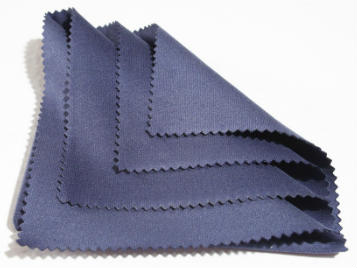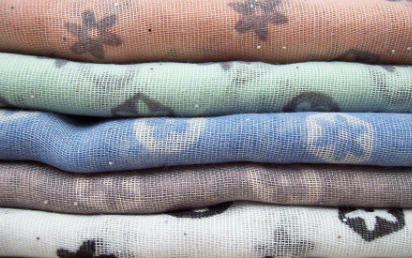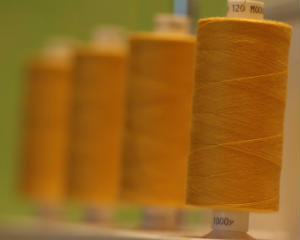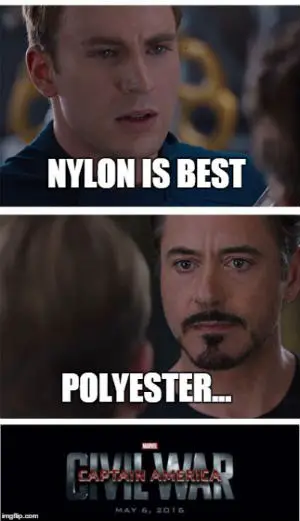Polyester and nylon are two of the most common materials. In fact, if you look around you now, there’s a good chance that there’s something that’s made up of either nylon or polyester around you. Both are synthetic materials but what are the differences between them?
Nylon a.k.a polyamide is well-known for being low maintenance and having good elasticity, strength, and resistance against abrasions, stains, and wrinkles. It’s also similar to silk in its smoothness and softness. Polyester shines for being water-resistant and is more breathable. It is also easy to care for and resistant to pilling and water-based stains.
The Mellanni Luxury Linens Bed Sheet Set is an excellent example of an affordable premium polyester product. You’ll also love the Soyater Nylon Crossbody Bag since it can keep your things safe from the rain or any spill accidents. Plus, it has several zippered compartments that allow you to stay organized all the time.
Polyamide vs Nylon vs Polyester: Comparison Table
[amazon table=”2225″]
What Is Polyester
Polyester is a man-made material that belongs to the polymers. It is composed of long chains of the chemical compound ester. Though it has many variations, the most popular is polyethylene terephthalate (PET) which is often used in clothing and packaging.
In order to turn polyester into a fabric, manufacturers first melt the plastic. Then, they use a spinneret to turn it into fibers. Next, the soft fibers are stretched to improve its strength once dry. Finally, they are woven into a fabric.
Polyester is commonly blended with natural fibers to improve its characteristics. For example, when cotton is blended with polyester, the resulting poly-cotton blend is softer.

Common Uses
- Apparel – Shirts, pants, jackets, hats
- Home Furnishings – Bed sheets, comforters, upholstered furniture
- Industrial – Yarns, ropes, conveyor belts
- Packaging – Bottles
What Is Nylon (Polyamide)
Just like polyester, Nylon is a synthetic material that belongs to the polymers. Instead of ester, its molecules are made up of amide groups. This is why nylon is also sometimes called polyamide.
To turn this plastic into fabric, nylon chips are first melted. The melted nylon can be then turned into fiber by pushing it through small holes. Finally, the nylon fibers are woven into fabric.
Nylon can also be blended with fibers like polyester, spandex, and cotton. For example, nylon can be made more durable by combining it with polyester. Or if added elasticity and comfort is the goal, spandex is blended.

Common Uses
- Clothing – Stockings, dresses, swimwear, activewear, windbreakers
- Home Furnishings – Bedspreads, draperies
- Military – Combat uniforms, parachutes, life vests, ropes, tents
- Packaging – Food packing films, oven bags, sausage sheaths
Are Nylon and Polyester the Same Thing? What Are the Differences?
Nylon and polyester are not the same thing. Though both are polymer synthetic materials, they differ in their composition. Polyester is composed of ester groups while nylon is made up of amide groups.
Feel
Since nylon was made to be just like silk, it has a softer and smoother feel than polyester. Polyester is lighter in weight, but they have a rougher feel to them. However, technological advances have made it possible for polyester to feel soft and flexible.
Strength and Durability
Despite being softer, nylon is naturally stronger than polyester. But, the finer thread of polyester makes it possible to create products with higher thread counts to improve its strength. Also, while nylon is resistant to abrasion, polyester is resistant to pilling.
Elasticity
Where nylon is very stretchable, polyester isn’t. In fact, it is nylon’s elasticity that makes it a strong material.
Breathability and Insulation
Nylon is the warmer material between the two. It also absorbs more water, so it takes longer to dry. As for polyester, it is water-resistant, so it dries faster. These characteristics mean that nylon has good insulation while polyester has a good moisture-wicking capability.
Both materials can be made quite breathable depending on their yarn size and weave. But it should be noted that wet fabric doesn’t allow air to circulate well. Since nylon is hydrophilic, it is a point against its breathability.

Color
Dye lasts longer in polyester materials. Since it is water-resistant, polyester repels the water in the dye but absorbs the dye itself. Nylon absorbs both the water and the dye, resulting in less of the dye binding to the fabric.
Static Electricity
Synthetic materials like nylon and polyester generate and retain static charge really well. The static electricity in them makes the fabric cling to your skin. Sometimes, when there’s low humidity, you’ll find that they can even gently shock you though it is quite harmless.
To reduce the static electricity in nylon and polyester, add some fabric softener in the wash cycle. Also, it’s better to air-dry these materials since using the dryer can increase the static electricity.
Flammability
Nylon and polyester are both flammable materials. They ignite slowly but rapidly melt and burn once ignited. But between the two, polyester is more heat-resistant since it has a higher melting point.
Allergies
Both synthetic materials do quite a good job in repelling common allergens like mold and mildew. But the finishing resin that is often applied to nylon and polyester can sometimes cause allergic reactions.
Biodegradability
Nylon and polyester are man-made materials, so they are not biodegradable. They also require a lot of energy and water resources to manufacture.
On the bright side, these synthetic materials are infinitely recyclable. Though they aren’t common yet, there are programs like Econyl which regenerates nylon textile and Eco Intelligent Polyester which recycles old polyester products.
Care
Both materials are low maintenance. They are resistant to mold and mildew. They also don’t stain and wrinkle easily.
Odor issues completely go away once nylon is washed. However, polyester is oleophilic so it can retain a faint smell even after washing. This characteristic also makes it susceptible to oil stains.
You can use your washing machine and dryer to clean your nylon and polyester clothing as well as long as you use low to medium temperatures. They can also usually be ironed using low heat but be sure to follow the instructions because not all products can be ironed.
Polyester can even be dry-cleaned. Unfortunately, you can’t dry-clean nylon since the solvents that are used in this process can melt the material.
Popular Products Made of Nylon and Polyester
Nylon and polyester are used in a variety of applications. Sometimes they can both be used to make certain products. Other times, one is chosen over the other because of their qualities.
For example, nylon and polyester are commonly used in making ropes and carpets. But when it comes to stockings, nylon is preferred due to its softness, strength, and elasticity. On the other hand, polyester is better for bed sheets because it is moisture-wicking and doesn’t wrinkle much.
Here are a couple of popular products that use these synthetic materials.
Mellanni Luxury Linens Bed Sheet Set
The Mellanni Luxury Linens Bed Sheet Set is a very popular polyester product with literally thousands of raving reviews. You can find it in different sizes and lots of lovely colors to suit your taste.
Since it’s made from a synthetic material, you might think that it’s too hot or plasticky in texture. But the truth is that this bed sheet set is just so soft, comfy and smooth.
It’s hypoallergenic and resistant to fading, staining and wrinkling too. It even remains quite cool in the summer and warm in the winter.
Once you place it on your bed, it won’t easily budge since it has deep pockets and an elastic all around it. It’s also easy to care for. It’s your washing machine and dryer that will do all the work.
The best thing about it? It’s so affordable!
Soyater Nylon Crossbody Bag
Keep your things safe when you go out by placing it in the Soyater Nylon Crossbody Bag. It has an adjustable strap so you can either wear it on your shoulders or across your body.
You can even choose from 6 vibrant shades to make sure that it goes well with your outfit.
But what I really like about this bag is that it has a lot of pockets. This way, you can stay organized and you can easily get whatever it is that you need.
This bag is made of nylon, so you know that it’s durable and easy to clean. It’s water-resistant too so you can keep your things safe from water even if it rains or you spill something on it.

Advantages and Disadvantages of Polyester
Pros
- Extremely strong and durable
- Stretchy
- Soft and smooth
- Repels mold and mildew
- Can be recycled
- Low maintenance
- Doesn’t wrinkle and stain easily
- Lightweight
- Abrasion-resistant
- Absorbs moisture easily
- Has insulating properties
Cons
- Flammable
- Not breathable
- Takes too long to dry
- Color doesn’t last long
- Flammable
- Can have a static charge
- Resins can cause allergic reactions
- Not eco-friendly
- Can’t be dry-cleaned

Advantages and Disadvantages of Nylon
Pros
- Can be woven to create a strong fabric
- Lightweight
- Smooth
- Strong
- Resistant to pilling
- Water-resistant
- Dries quickly
- More breathable
- Color lasts
- Has a higher melting point
- Repels mildew and mold
- Can be recycled
- Doesn’t wrinkle easily
- Resists water-base stains
- Low maintenance
- Can be dry-cleaned
Cons
- Poor elasticity
- Has static charge
- Flammable
- Resins can cause allergic reactions
- Not eco-friendly
- Susceptible to oil stains

Frequently Asked Questions
Nylon vs Polyester – Which Fabric Is Better for Jackets?
In general, polyester is better for jackets because it is cooler and more breathable. Polyester is also water-resistant and good at wicking moisture away, allowing it to dry faster.
Is Nylon or Polyester Waterproof?
Both aren’t waterproof but polyester absorbs less moisture. For these materials to be waterproof, manufacturers coat or treat them with waterproofing chemicals.
Polyester vs Nylon – Which Is Better for Rain?
Though polyester is more water-resistant, you’ll find that nylon a.k.a polyamide is more prevalent when it comes to outdoor applications like umbrellas, tents, and bags. This is because nylon is more durable and weather-resistant.
Does Nylon Breathe Better Than Polyester?
Polyester breathes better than nylon. Nylon absorbs moisture easily, blocking air from circulating.
Do Nylon and Polyester Shrink?
Most synthetic materials, including nylon and polyester, do not shrink.
Is Nylon Thread Stronger Than Polyester?
If you consider their weight, nylon is inherently stronger than polyester. But polyester fiber can be woven in such a way that the resulting product will have a higher thread count to boost its strength.
Is Nylon or Polyester Stretchy?
Nylon is stretchy but polyester is not.

Final Words
Polyamide vs Nylon vs Polyester: And the winner is…
As you can see, these fabrics are similar in a lot of ways. Both are man-made materials that can be blended with natural materials. They’re also non-biodegradable but can be recycled infinitely.
They have many contrasting characteristics as well. For example, nylon or vs polyamide has good insulating properties, but polyester is more breathable. Also, the first is oil-resistant while the latter is water-resistant.
To keep it simple, we can say that each of these materials has its own qualities that make them shine. And it’s all thanks to these qualities that polyester and nylon have a wide range of applications.



